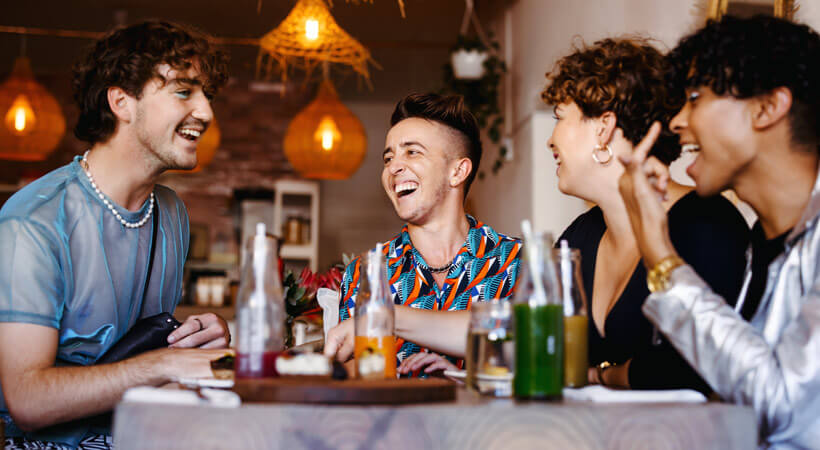Cheers and Challenges: Alcohol & Cancer Risks in the LGBTQ+ Community
In this blog, we are looking to explore a topic that often comes up in relation to our community – alcohol. This piece will explore the links between our community’s alcohol and cancer risks and what that means for LGBTQ+ people. You may already know that LGBTQ+ individuals tend to drink more alcohol than the general population. But did you know that drinking alcohol can lead to an increased risk of cancer?
So, stay with us, and we will give you an informative overview of our community’s relationship to alcohol and what this means in relation to cancer.

The Morning After A Big Night
Most of us have experienced a night of fun where alcohol has been a dominating part of the fun factor. So, you would also, of course, know that he/she/they who lives large for the night… must inevitably wake up the next morning. There are a few not-so-desirable things that can happen when drinking.. (maybe some of these might sound familiar?)
- Headache
- Nausea
- Physical injury to yourself or others
- Regretted and/or unsafe sex
- Social embarrassment (read: awkward mems or non-existent mems that pop up in photos later…)
- Hang-xiety – a fun lil term to describe something not at all fun. Hangxiety is the physical and mental feelings of anxiety that can accompany a hangover and the days following alcohol use.
If you experience the above side effects from time to time, they likely feel manageable. However, the side effects of drinking are not just short-term. These short-term effects can also be a reminder of the bigger picture. They can also be things that we reflect on and help us to assess our relationship with alcohol, the role for better or worse that alcohol might be playing in our lives now, and the longer-term impacts it could be having on us.
Stay with us as we briefly investigate some research about our community’s relationship with alcohol.

Our Rainbow Cheers
Studies show LGBTQ+ people like to drink more than the general population[1],[2]. This is particularly important to be aware of if you assess your drinking intake in relation to your LGBTQ+ friends and partners.
Most of us enjoy a drink, but many of us are overdoing it:
- A quarter have more than 10 drinks a week (the drinking guidelines).
- Nearly half drink every week or more.
- About 90% of us have had a drink in the past year.
- Many of us drink more often than the general population.[2]
- And we often think we drink less than others.[3]
The sobering reality is that there is no safe alcohol consumption level when talking about cancer risk. Why? Because every drink increases your risk of getting an alcohol-related cancer, and the bottom line is that no level of drinking is completely safe. Now, this is vital knowledge to hold, but if drinking is a part of your life and you are not looking to eliminate it, then it’s essential to know that you can reduce your cancer risk by drinking within NHMRC guidelines.
If you are looking to prioritise your health and well-being, knowing what constitutes harmful levels of alcohol consumption will help you do this. Encouraging others in the community to reduce their drinking can also be a very positive action. Always remember to do so in an empowering and non-judgemental manner, as the reasons we drink are varied and can be complex, including to help with needed social connectedness or as a coping mechanism. It’s vital for wellbeing, and behaviour change that we have plans in place to get support and to have healthy substitutions for drinking ready to go when cutting down on alcohol.

The Many Faces of Why We Toast
Among us, there are varied reasons for reaching for that alcoholic beverage of choice. Some motivations (conscious or unconscious) include connecting with friends, pleasure, fun, seeking social enhancement, coping with minority stress, social pressure, stress management, anxiety, and depression. Whether we’re raising our glasses in social environments, connecting with friends, expressing our authentic selves, or drinking to help cope with the tougher stuff in life, it’s essential to be aware of how alcohol fits into our lives. This is particularly important to be aware of because (as mentioned earlier) most of us underestimate our level of alcohol consumption and, therefore, related risks.[4]
Confronting Cancer Risks
We now know alcohol is proven to cause cancer. Which cancers, you might ask? There are eight altogether:
- mouth and upper throat cancer
- larynx (voice box) cancer
- oesophagus (food pipe) cancer
- chest/breast cancer
- stomach cancer
- liver cancer
- bowel cancer.
When looking at this list, the important factor to remember is that the amount of alcohol consumed directly relates to your increased risk. So, by drinking less alcohol, you reduce your risk of cancer[5].
Our research study Alcohol related beliefs, and knowledge regarding cancer risks in the LGBTQ+ community in NSW it was found that knowledge around alcohol-related cancer risk in the LGBTQ+ community needs improvement. In response to this, CAN WE will launch an alcohol and cancer risks campaign in 2024; the aim of this campaign will be to improve alcohol and cancer risk awareness in the LGBTQ+ community.
The Buzzkill of Negative Consequences
While it’s natural to cherish the camaraderie and joy of spending time with friends and community, including having a drink together, it’s healthy to recognise the potential negative consequences of excessive alcohol consumption. From pesky headaches and arguments to regretted and/or unsafe sexual encounters, these actions and others can all cast a cloud over our often otherwise fabulous lives. So, why not think about your consumption, how it fits with this information, and whether you’re keen to set boundaries that make you feel empowered around your relationship with alcohol?
Check out our Cutting Back On Alcohol page for a look at everything from why we drink, to what a standard drink is and tips for drinking less.
Knocking Down Barriers to Seeking Help
As a community known for our resilience, it’s essential to remember that seeking help is an act of strength, not weakness. Many of us may hesitate due to feelings of embarrassment, shame, or fear of judgment. Some may not feel ready to seek help, while others may not even realise their current alcohol use could be harmful. You might face challenges like time constraints, financial limitations, or uncertainty about where to find support. But fear not! These barriers can be overcome and there is good news on the other side of those barriers – our research study showed that 84% of participants who sought help received it[6].
Support services to check out:
- Check out our Tips To Cut Down On Alcohol for practical ideas.
- ACON’s Pivot Point: A good place to start is a fabulous resource developed by and for community.
- ACON’s Substance Support counselling team is a free and confidential counselling service for LGBTQ+ people looking for support in relation to their use of alcohol and other drugs.
- Drinking and smoking often go hand in hand, like burgers and fries. If you are looking for ways to cut down on cigarettes, check out our This Could Be The One
Conclusion
By staying informed about alcohol and cancer risks, being mindful of our habits and relationship with alcohol , and supporting one another through challenges, we can live our best lives while safeguarding our health. Let’s celebrate our vibrant LGBTQ+ community, where community care and support are our greatest assets.
THANK YOU
Thank you to all the fantastic community members who contributed to our Alcohol & Cancer Risk Research carried out in partnership with the National Drug and Alcohol Research Centre (NDARC) and the Cancer Institute NSW. There is very little research on our communities about alcohol and cancer risks, and we appreciate every one of you who gave up your time and shared your experiences.
Your voices will help shape our next campaign and inform health promotion for LGBTQ+ communities in the future.